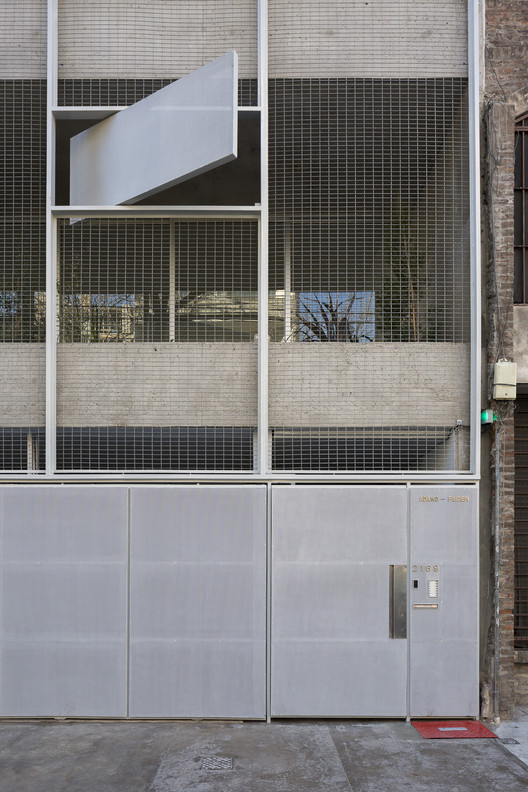Port Melbourne Football Club k20 Architecture
2015-09-01 17:00
架构师提供的文本描述。澳大利亚维多利亚港墨尔本足球俱乐部体育和社区设施于2015年完工,是当地菲利普港委员会委托建造的一座单层建筑,为所有人提供一个可供使用的多用途空间。该项目包括一个可容纳200人的功能室、行政办公室和商店、会议室和会议室以及一个商业厨房和酒吧。
Text description provided by the architects. Completed in 2015, Port Melbourne Football Club Sporting and Community Facility, Victoria, Australia, is a single storey building commissioned by the local City of Port Phillip council to provide a multipurpose space accessible to all. The program includes a 200-person capacity function room, administration offices and stores, meeting and conference rooms and a commercial kitchen and bar.
© k20 Architecture - Peter Bennetts
位于北椭圆形港北角,该展馆旨在为成立129年的墨尔本港足球俱乐部提供新的总部。该项目由澳大利亚足球联盟(AFL)、维多利亚足球协会(AFL)和体育公司共同出资。
Situated on the Northern corner of the North Port Oval, the pavilion was designed to provide new headquarters for the 129-year-old Port Melbourne Football Club. The project was jointly funded by the Australian Football League (AFL), AFL Victoria and Sports & Recreation Victoria and was delivered within a tightly controlled fixed budget. The building was designed and delivered for $2,400/sqm. The construction efficiency rate was achieved via a value managed design process, which in turn enabled a high level of design innovation.
© k20 Architecture - Peter Bennetts
设计理念是创造一座反映周围环境的建筑。在山坡上,建筑的形式与当地墨尔本港的原始工业背景相呼应。这也反映在物质性,因为外部是由一个最小的调色板的混凝土,玻璃,木材和钢。木材包层的内部和外部双重用途,以隐藏和揭示程序,以及保留所需的玻璃量,因为预算限制的项目意味着玻璃主要用于观看空间。出现在东、南高地上的“V”形被用来微妙地引用建筑物的用途,作为VFL的家,它的形式被用来使建筑物提升和上升,以确保通过建筑物的视线,将人们与游戏连接起来。
The design concept was to create a building reflective of its surroundings. Embedded in the hillside, the form of the building echoes the raw industrial context of the vernacular seen in the local context of Port Melbourne. This is also reflected in the materiality as the exterior is made up of a minimal palette of concrete, glass, wood and steel. The timber cladding both interior and exterior serves a dual purpose to conceal and reveal the program within as well as retain the amount of glazing required as budget constraints for the project meant glazing was devoted primarily to the viewing space. The ‘V’ form that appears on the East and South elevations was adopted as a subtle reference to the buildings purpose as home to VFL and its form was used to enable the building to lift and rise to secure view lines through the building to connect people with the game.
该建筑提供了通用的通道和一个新的街道存在到体育区,通过一条可到达的木材木丛通道,蜿蜒穿过山坡的弯道,并连接到展馆入口。建筑物本身是由两个部分组成的,通过一条通道连接着游客,通过大楼把游客送到外面的运动区。展馆的后部反映了其内部规划的勤劳性质-便利设施、厨房、商店和凉爽的房间。展馆的前半部分被严格的树皮覆盖,围绕着社会空间的内部程序形成。入口看起来像一个扁平的棚屋一样的形式打开给180度的北港椭圆形与地板到天花板低E开放玻璃窗,以确保通畅的视野,现场活动从舒适的内部。
The building provides universal access and a new street presence to the sporting precinct via an accessible timber cladded pathway that zigzags its way through the camber of the hillside and connects to the pavilion entry. The building itself is made up of two parts connected by a pathway which delivers and connects visitors through the building to the sporting precinct beyond. The rear part of the pavilion reflects the industrious nature of its interior program - amenities, kitchen, stores and cool rooms. The front part of the pavilion is clad in Stringy Bark and shaped around the internal program of social spaces. What appears at entry to be a flat shed like form opens up to give 180 degree vista of the North Port Oval with floor to ceiling Low-E openable glass windows to ensure unobstructed views to the on-field activities from the comfort of the inside.
© k20 Architecture - Peter Bennetts
木材在整个结构中使用,覆层系统的设计是为了提供成本效益的结果,使用标准的现成本地来源的材料和部件。该项目的目的是使当地劳动力能够熟练地组装和建造建筑,同样依靠当地现有的技术。建筑施工方法采用可持续来源的硬树皮木材-一种高碳汇材料,旨在提供高水平的当地含量和当地劳动力。灯光、布局和地毯设计都是从不同的入口点穿过建筑物的路径的分形表达,在足球比赛中,玩家可能穿过运动场的路径与之相呼应。
Timber is used throughout the structure and the cladding systems are designed to provide cost effective outcomes using standard off the shelf locally sourced materials and components. The project was in turn designed to enable local labour to skilfully assemble and construct the building relying equally on locally available technology. The building construction methodology adopted sustainably sourced Stringy Bark timber- a high carbon sink material, and was designed to provide high levels of local content and local labour. The lighting layout and carpet design are fractal- like expressions of paths that travel through the building from various entry points and echo the paths a player might travel across the playing field during a game of football.
© k20 Architecture - Peter Bennetts
Architects k20 Architecture
Location Victoria, Australia
Category Recreation & Training
Photographs Peter Bennetts
 举报
举报
别默默的看了,快登录帮我评论一下吧!:)
注册
登录
更多评论
相关文章
-

描边风设计中,最容易犯的8种问题分析
2018年走过了四分之一,LOGO设计趋势也清晰了LOGO设计
-

描边风设计中,最容易犯的8种问题分析
2018年走过了四分之一,LOGO设计趋势也清晰了LOGO设计
-

描边风设计中,最容易犯的8种问题分析
2018年走过了四分之一,LOGO设计趋势也清晰了LOGO设计


































































